Reconstructed Ancient Soundscapes
This collection will provide soundscape recordings ready to use for teachers in their classes.
You can listen directly online or download each sound with its fiche and image by clicking on the download button. Once downloaded, open the compressed file or right-click to extract its content.
Many thanks to Hvolris Jernalderlandsby, Middelaldercentret and Earswideopen.dk.
This work is licensed under CC BY 4.0
The Iron Age
For this collection, you can download a different set of pictures here
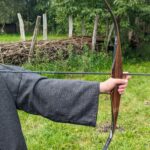
Archery
You hear archery, voices, and a little wind. The best part is at the end of the clip.
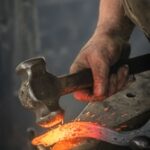
The blacksmith
A blacksmith using a bellows to increase the temperature of the ash so he can forge.
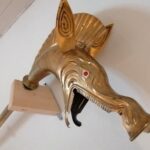
Carnyx
In the audio clip, signals are blown on a Carnyx, a war trumpet from the Iron Age. There are only 5 archaeological finds of the Carnyx in the world, in Scotland and France. A replica made from one of the inner plates of the world-famous Gundestrup Cauldron is blown. At the end of the clip, footsteps are heard and the Carnyx is placed against a wall. This way, students can hear that it is made of metal. The Carnyx’s head depicts a wild boar with red-rimmed eyes in anger. Perhaps it refers to a double-headed boar, which is associated with death and destruction.
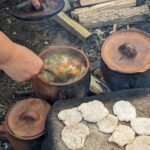
Cooking
You’re inside. You hear voices and a person stirring a wooden spoon in a clay pot. A person tastes the food and says: “I think it needs a little more”.
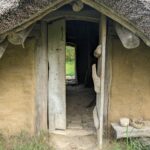
Entering a house
Two boys are heard opening a solid wooden door and closing it again. In the background, the village residents are heard.
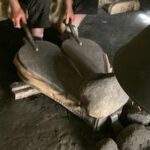
Fanning the flame
Voices are heard and a rhythmic breathing to the fire.
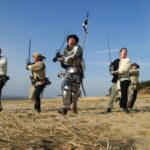
Fighting
The sound clip is windy despite the wind hood. It’s a soundscape where there is a battle between several warriors. You can hear the audience, shouts between warriors, sword fighting. Swords against shields. One of the warriors does not want to be baptized, which is the cause of the fight.
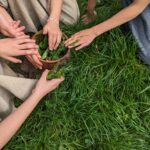
Picking herbs
Girls picking herbs (or rather grass) in a rhythmic way. Light wind, voices in the background and the girls talking at the end of the clip.
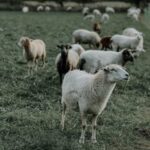
Sheep breathing
A sheep breathing. It’s louder at the beginning of the clip, maybe the sheep was nervous? further into the clip it becomes more uniform and rhythmic.
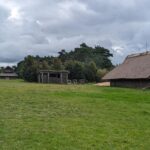
Village sounds
Wind is heard, voices in the background talking and at the end of the clip, someone is heard breaking something.
The Medieval
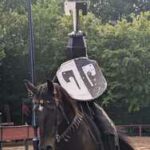
Announcing the knights
The herald announces that the knights are on their way. From the left side you hear first a horse and then two horses moving to the right. Notice the speed increases… there’s a bit of noise from the recorder. The knights ride into the jousting arena and are greeted with applause, cheers and even boos (each side of the arena holds a knight) The herald declares in Danish and German that the jousting is ready to begin, and the knights greet the audience.
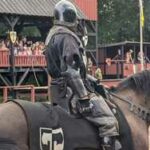
Announcing the winner
The herald declares Sir Wolfram of Lauterbach as the winner of the tournament. There is cheering, but also booing, as the local hero, Sir Henrik Svane did not win.
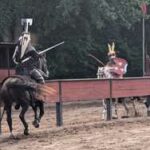
At the tournament
We are touring between the local gentleman Sir. Henrik Svane and Sir Wolfram of Lauterbach. They ride two rounds against each other. The herald announces them and explains that they get 2 points each in the first round. There is audience chatter, horses riding, lances being broken, cheers and applause.
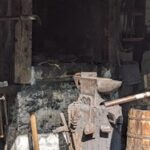
The Blacksmith
The audio clip of a blacksmith forging a bracket. You hear the sound of a hammer against an anvil, the bellows and at the end of the clip he talks to customers
Attention – the hammering is quite loud!
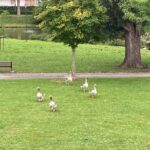
Geese
You hear geese that are not entirely happy with humans getting close. Wind in the treetops and in the background you hear people talking in the town.
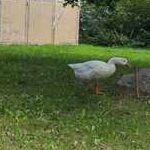
Goose
In the audio clip, geese are heard unhappy with humans coming close. There are people talking in the background and the blacksmith is heard hammering. At around 0:43, a gunshot is heard and then geese. (The city is around the year 1413 AD and they have just got the first firearms to help protect the city from attack)
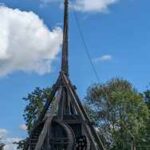
The Great trebuchet
At the start of the audio clip, you hear the creak of the counterweight on the small trebuchet that has just been fired. The town bailiff suddenly shouts “Attention, it’s being launched”, followed by a metallic click of the firing mechanism, followed by a whoosh in the air from the stone being thrown. Throughout the clip, you can hear the voices of the townspeople and applause after the launch.
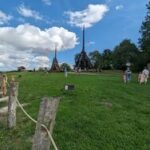
The small trebuchet
The city bailiff declares, “there is no reason to be afraid or intimidated. They have everything under control” you can hear the townspeople talking. The trebuchet is fired, metal sounds a whisper in the air, the counterweight box creaking, the crowd cheering.
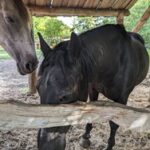
Horse breathing
You´ll hear the breath of the knights horse and a bit of wind.
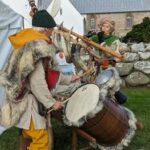
Music
There are two musicians playing drums, bells and recorder. Voices from the city are heard in the background and a dog barks several times in the clip. A great clip for identifying different sounds and imagining …. what’s going on here?
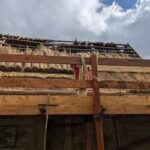
The thatcher
Unfortunately, the clip is a bit windy, but you can clearly hear the carpenter hitting the reeds in the roofing work.
The Sound of Yule
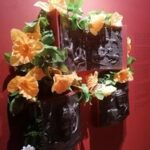
Beesbirdsgarden
In the audio clip, birds and bees are heard in a summer landscape to illustrate a special kind of gnome: the garden gnome, who, as the name suggests, lives in people’s gardens. Occasionally, some garden elves are liberated from ugly gardens and released into the wild where they truly belong.
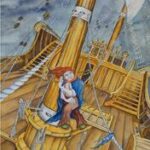
Caulking
A ship’s carpenter can be heard caulking a wooden ship with a tool, hammer and various metal tools. Not many people recognise this elf. But in the old days, it was believed that the elf moved with the tree from the forest. The elf helped keep an eye on the condition of the ship… by walking around with a hammer and knocking on the tree. If it stopped tapping, it was a bad sign that the ship would soon sink. If you were unlucky enough to see the goblin, it was a sign that you were about to die!
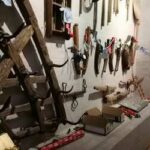
Cows in stable
The audio clip shows cows roaring in different strengths in a barn. The clip is meant to illustrate the farmer’s elf who helped out on the farm. In return, the farmer gave the elf a bowl of porridge to thank him for his help, and for Christmas, there was a knob of butter, sugar and cinnamon and a jug of elf beer.
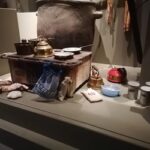
Kitchen
The audio clip shows different sounds from the kitchen, especially the rattling of different utensils. The clip is meant to draw students’ attention to the kitchen where the house elf lives.
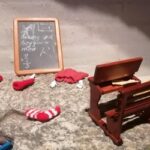
School sounds
The audio clip is from a school where there is chatter, reverberation, etc. the audio clip should give students an idea of the school gnome, when it is nearby, books are lost, homework is forgotten, clothes are lost, etc.

Sound of a typewriter
You hear a travel writing machine, unpack, insert paper and write. Reverse the roller and write again…. press the space bar. The clip is intended to remind students of a little-known gnome called “The Setter Gnome”. It is found in newspaper editorial offices, writers’ offices and schools….when it is in the vicinity, spelling mistakes, typos and yes….you can even turn the letters the wrong way round.

Walking in snow
There’s a person walking in snow.

Wrapping a gift
The audio clip shows a person wrapping a gift: cutting paper, applying tape and ribbon.
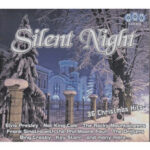
X-mas tune
It’s a keyboard playing “Silent night” a world-famous Christmas song that students can associate with emotionally.
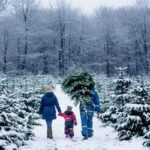
Yuletree
We’re out in the forest cutting down a Christmas tree. It’s a short clip and you need to turn up the sound.
The Stone Age
This collection is made available with the permission of Earswideopen.dk.
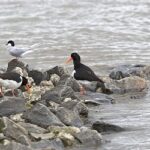
Beach birds
You can hear the water of the fjord against the shore. A large flock of geese flies by.
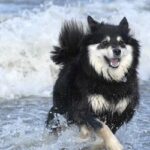
Dog and sea
There are powerful waves from the sea crashing against the shore and a dog panting. A clip that can help you talk about the emotions evoked by the sounds. The dog was the first animal to be domesticated by humans, and dogs were often so loved that they were given special burials when they died.

Sea
You hear the Kattegat (the waters between Jutland and Norway) on an autumn day. Waves are heard crashing against a wide sandy beach and at 0.24 min a dog is heard panting. In this case, it is a dog of the Finnish Lap breed as in the picture, but a Schapendoes
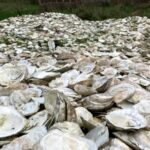
Walking on Kitchen Midden
A kitchen midden is a large pile of waste oyster shells from 5500-3950 BC called the Ertebøllekultur. Footsteps are heard on shells and someone knapping flint on the shell heap
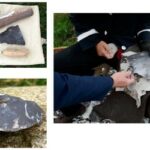
Elk against flint
There is the sound of flint being worked first with Elk antlers, the clinking of flint being knapped off. You can also hear the flint block being moved around on a skin that protects the flintknapper’s legs. You can hear the flint being polished with a stone.
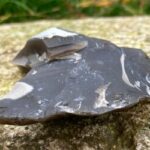
Stone against flint
You can hear continuesly a stone being hit on a stone / flint. Sometimes a noise of stone scraping on a stone can be heard. There is a background noise of somebody walking on the ground consisting of stones or gravel.
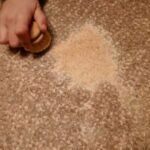
Grinds grain
Grain is heard being ground on a push grinder. Notice the rhythm and the flour being swept up with a goose wing
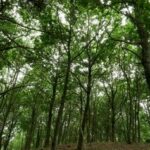
Oakwood in a rainy day
The audio clip is an oak forest on a rainy day. Note that there are multiple “layers” and the sound is like waves.
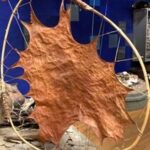
Scraping hide
The sound clip features rhythmic scraping against rawhide stretched on a frame of branches. A piece of worked flint is used to remove meat scraps, tendons, and membranes.
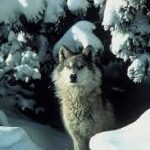
Wolf
The audio clip starts with a single wolf that turns into an entire wolf pack; eventually crows are heard in the background and two microphones get too close. The audio clip is great for talking about emotions – what do you think when you hear it? Some might be scared, while others might be fascinated by it.

Co-funded by the European Union. Views and opinions expressed are however those of the author(s) only and do not necessarily reflect those of the European Union or the European Education and Culture Executive Agency (EACEA). Neither the European Union nor EACEA can be held responsible for them.
(Project code: 2022-2-DK01-KA210-SCH-000096788)
